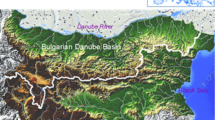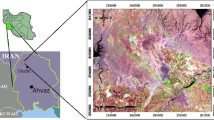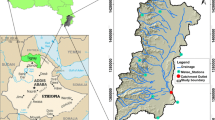Abstract
Gediz Basin, located in the western part of Turkey constituting 2% land of the country, has an important groundwater potential in the area. Alasehir sub-basin, located in the southeast of the Gediz Basin and subject to the extensive withdrawal for the irrigation, constitutes the study area. Natural recharge to the sub-basin due to precipitation is numerically investigated in this study. For this purpose, 25 research wells, whose depths range from 20 to 50 m, were drilled to observe the recharge and collect the necessary field data for the numerical model. Meteorological data were collected from 3 weather stations installed in the study area. The numerical model HYDRUS was calibrated using the field water content data. Soil characterization was done on the core samples; the aquifer characterization was performed, and the alluvial aquifer recharge due to precipitation was calculated. As a result, the computed recharge value ranges from 21.78 to 68.52 mm, with an average value of 43.09 mm. According to the numerical model, this amount of recharge corresponds to 10% of the amount of annual rainfall.



















Similar content being viewed by others
References
Anlauf, R., Rehrmann, P., & Schacht, H. (2012). Simulation of water uptake and redistribution in growing media during ebb-and-flow irrigation. Journal of Horticulture and Forestry, 4(1), 8–21.
Batalha, M. S., Barbosa, M. C., Faybishenko, B., & Van Genuchten, M. T. (2018). Effect of temporal averaging of meteorological data on predictions of groundwater recharge. Journal of Hydrology and Hydromechanics, 66(2), 143–152.
Blonquist, J., Jr., Jones, S. B., & Robinson, D. (2006). Precise irrigation scheduling for turfgrass using a subsurface electromagnetic soil moisture sensor. Agricultural Water Management, 84(1-2), 153–165.
Brooks, R. H., & Corey, A.T. (1964). Hydraulic properties of porous media, Hydrol. Paper No. 3, Colorado State Univ., Fort Collins, CO.
Caiqiong, Y., & Jun, F. (2016). Application of HYDRUS-1D model to provide antecedent soil water contents for analysis of runoff and soil erosion from a slope on the Loess Plateau. Catena, 139(1-8), 1–8.
Çiftçi, N. B., & Bozkurt, E. (2009). Evolution of the Miocene sedimentary fill of the Gediz Graben, SW Turkey. Sedimentary Geology, 216, 49–79.
Dandekar, A., Singh, D., Sarangi, A., & Singh, A. (2018). Modelling vadose zone processes for assessing groundwater recharge in semi-arid region. Current Science, 114(3), 608–618.
De Silva, C. (2015). Simulation of potential groundwater recharge from the Jaffna Peninsula of Sri Lanka using HYDRUS-1D Model. OUSL Journal, 7, 43.
Devine, R. S. (1995). The trouble with dams. Atlantic Monthly, 276(2), 64–74.
Durner, W. (1994). Hydraulic conductivity estimation for soils with heterogeneous pore structure. Water Resources Research, 32(9), 211–223.
E.İ.E. (2017). Güneş Enerjisi Potansiyel Atlası (GEPA). Retrieved from Türkiye Cumhuriyeti Enerji ve Tabi Kaynaklar Bakanlığı: http://www.eie.gov.tr/MyCalculator/pages/45.aspx.
Hou, L., Zhou, Y., Bao, H., & Wenninger, J. (2017). Simulation of maize (Zea mays L.) water use with the HYDRUS-1D model in the semi-arid Hailiutu River catchment, Northwest China. Hydrological Sciences Journal, 62(1), 93–103.
Kambale, J., Singh, D., & Sarangi, A. (2017). Impact of climate change on groundwater recharge in a semi-arid region of northern India. Applied Ecology and Environmental Research, 15(1), 335–362.
Knoppers, R., & van Hulst, W. (1995). De keerzijde van de dam: Novib.
Kosugi, K. (1996). Lognormal distribution model for unsaturated soil hydraulic properties. Water Resources Research, 32(9), 2697–2703.
Melki, A., Abdollahi, K., Fatahi, R., & Abida, H. (2017). Groundwater recharge estimation under semi arid climate: case of Northern Gafsa watershed, Tunisia. Journal of African Earth Sciences, 132, 37–46.
Mualem, Y. (1976). A new model for predicting the hydraulic conductivity of unsaturated porous media. Water Resources Research, 12(3), 513–522.
Nasta, P., Adane, Z., Lock, N., Houston, A., & Gates, J. B. (2018). Links between episodic groundwater recharge rates and rainfall events classified according to stratiform-convective storm scoring: a plot-scale study in eastern Nebraska. Agricultural and Forest Meteorology, 259, 154–161.
Pearce, F. (1992). The dammed: rivers, dams, and the coming world water crisis.
Richards, L. A. (1931). Capillary conduction of liquids through porous mediums. Physics, 1(5), 318–333.
Rushton, K., & Ward, C. (1979). The estimation of groundwater recharge. Journal of Hydrology, 41(3), 345–361.
Simunek, J., Köhne, J. M., Kodešová, R., & Šejna, M. (2008). Simulating non equilibrium movement of water, solutes, and particles using HYDRUS: a review of recent applications. Soil and Water Research, 3(Special Issue 1), S42–S51.
Szymkiewicz, A., Gumuła-Kawęcka, A., Šimůnek, J., Leterme, B., Beegum, S., Jaworska-Szulc, B., & Jacques, D. (2018). Simulations of freshwater lens recharge and salt/freshwater interfaces using the HYDRUS and SWI2 packages for MODFLOW. Journal of Hydrology and Hydromechanics, 66(2), 246–256.
Thornthwaite, C. W. (1948). An approach toward a rational classification of climate. Geographical Review, 38(1), 55–94.
Tonkul, S. (2018). Natural groundwater recharge in the Alaşehir Sub-basin (Gediz Basin, Turkey), İzmir Institute of Technology, The Graduate School of Engineering & Science, Master Thesis
Van Genuchten, M. T. (1980). A closed-form equation for predicting the hydraulic conductivity of unsaturated soils 1. Soil Science Society of America Journal, 44(5), 892–898.
Vogel, M. (2019). Effects of model spin-up on simulated recharge using the Hydrus-1D vadose zone model.
Vogel, T., & Cislerova, M. (1988). On the reliability of unsaturated hydraulic conductivity calculated from the moisture retention curve. Transport in Porous Media, 3, 1–15.
Yang, Z.-Y., Wang, K., Yuan, Y., Huang, J., Chen, Z.-J., & Li, C. (2019). Non-negligible lag of groundwater infiltration recharge: a case in Mu Us Sandy Land, China. Water, 11(3), 561.
Funding
This work was financially supported by Scientific and Technological Research Council of Turkey (TÜBİTAK) with the project number of 115Y065.
Author information
Authors and Affiliations
Corresponding author
Additional information
Publisher’s note
Springer Nature remains neutral with regard to jurisdictional claims in published maps and institutional affiliations.
Rights and permissions
About this article
Cite this article
Tonkul, S., Baba, A., Şimşek, C. et al. Groundwater recharge estimation using HYDRUS 1D model in Alaşehir sub-basin of Gediz Basin in Turkey. Environ Monit Assess 191, 610 (2019). https://doi.org/10.1007/s10661-019-7792-6
Received:
Accepted:
Published:
DOI: https://doi.org/10.1007/s10661-019-7792-6




